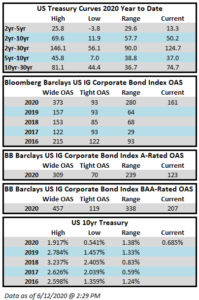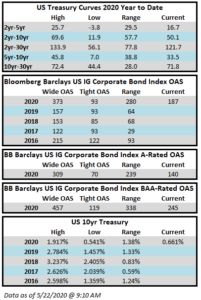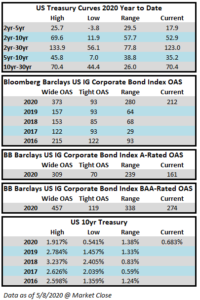Fund Flows & Issuance: According to a Wells Fargo report, flows week to date were +$2.0 billion and year to date flows stand at $34.1 billion. New issuance for the week was $5.8 billion and year to date issuance is at $213.5 billion.
(Bloomberg) High Yield Market Highlights
- S. junk bonds are headed for a second week of gains after investors poured money into retail funds following a retreat last week. Two deals are expected to price Friday, bringing the week’s tally to more than $8b.
- Junk bond funds reported an inflow of $2b for the week, following a $5.5 billion exodus the week before
- Junk bond spreads and yields came under pressure as equities slumped and oil prices fell
- Spreads widened 8bps to close at +597 and yields jumped 7bps to 6.57%
- The index posted a second day of losses, down 0.12%
- Barclays’ strategist Brad Rogoff wrote on Friday that “the rising number of Covid-19 cases in the U.S. could potentially be a catalyst for another sell-off,” especially if states re-establish lockdowns. “The re-escalation of virus cases remain an overhang, potentially turning the V- shaped recovery into a W.”
- Stock futures wavered on the fears and oil prices slid as the International Energy Agency warned that a jump in virus cases could derail the economic recovery
(Wall Street Journal) Judge Orders Pipeline Shut Down, Citing Faulty Environment Permit
- A federal judge ordered the Dakota Access pipeline to shut down by next month because it was improperly granted a key environmental permit, a major setback for operator Energy Transfer LP and the American shale-drilling industry.
- S. District Judge James Boasberg in Washington ruled Monday that the pipeline, which has been carrying oil since 2017, should be turned off until the U.S. Army Corps of Engineers completes a new environmental-impact statement. That process is expected to take 13 months.
- The ruling, which comes a day after the builders of the $8 billion Atlantic Coast Pipeline pulled the plug on that project, is the latest example of how difficult it has become for companies to get fossil-fuel conduits approved in the U.S. amid stiff opposition from environmentalists, landowners and Native American tribes.
- It comes as the Trump administration’s efforts to fast-track pipelines and other energy infrastructure projects have faltered amid legal challenges. The ruling threatens to further create hardship for American shale drillers operating in the Bakken Shale region of North Dakota, which have been rocked this year by falling demand for oil due to the coronavirus pandemic.
- “The Court does not reach its decision with blithe disregard for the lives it will affect. It readily acknowledges that, even with the currently low demand for oil, shutting down the pipeline will cause significant disruption to DAPL, the North Dakota oil industry, and potentially other states,” Judge Boasberg wrote.
- Energy Transfer said it planned to pursue all available legal and administrative remedies to stop the pipeline from being shut down.
- “We believe that Judge Boasberg has exceeded his authority in ordering the shutdown of the Dakota Access pipeline, which has been safely operating for more than three years,” spokeswoman Vicki Granado said.
- The court had previously found the Army Corps in violation of the National Environmental Policy Act when it granted approval to build and operate part of the pipeline that runs under Lake Oahe, a reservoir on the Missouri River, which straddles North and South Dakota.
- It said the Army Corps failed to produce a required environmental review.
- Owners of Dakota Access had told the court that they could lose as much as $643 million in the second half of 2020 and $1.4 billion next year if the pipeline is shut down.
- “There is no viable pipeline alternative for transporting the 570,000 barrels of Bakken crude that DAPL is capable of carrying each day,” the pipeline’s owners have said.
- Judge Boasberg acknowledged his decision will have substantial impacts for the oil industry in North Dakota, which has been struggling this year with low prices due to the drop in demand caused by the virus.
- “Yet, given the seriousness of the Corps’ NEPA error, the impossibility of a simple fix, the fact that Dakota Access did assume much of its economic risk knowingly, and the potential harm each day the pipeline operates, the Court is forced to conclude that the flow of oil must cease,” he wrote.
(Bloomberg) Energy Transfer Isn’t Shutting Dakota Access Despite Ruling
- Energy Transfer LP said it’s not making any moves to empty its Dakota Access oil pipeline after a judge on Monday ordered the conduit shut while a more robust environmental review is conducted.
- The Dallas-based company run by billionaire Kelcy Warren said it’s also accepting requests for space on the pipeline in August. The U.S. District Court for the District of Columbia had ordered the pipeline to be drained by Aug. 5.
- “We are not shutting in the line,” Energy Transfer spokeswoman Vicki Granado said in an email when asked if the company had begun emptying the pipeline. Judge James E. Boasberg “we believe exceeded his authority and does not have the jurisdiction to shut down the pipeline or stop the flow of crude oil.”
- It’s the latest sign that Energy Transfer is preparing for yet another battle over the Dakota Access crude pipeline, which four years ago drew months of on-the-ground protests from environmental groups and tribes opposed to the project’s route across Lake Oahe, a dammed section of the Missouri River just a half-mile from the Standing Rock Indian Reservation in the Dakotas.
- In Washington, energy lobbyists have mused that the shutdown order would be difficult to enforce, according to three people familiar with the discussions.
- Height Securities LLC also predicts the unprecedented ruling to shut down Dakota Access because of a violation of the National Environmental Policy Act is unlikely to withstand review by the D.C. Circuit Court of Appeals, according to a research note for clients.
- When asked whether Energy Transfer plans to defy Boasberg’s decision if it remains in effect Aug. 5, Granado reiterated that the company doesn’t think he has the authority to shut the line. She later said Energy Transfer’s decision to refrain from emptying the pipeline isn’t meant as an act of defiance, “rather a statement to say we are not in the process of shutting in the line and do not believe he has the authority to order this.”
(Wall Street Journal) Buffett’s Bet Is a Midstream Buy Signal
- After months of quiet browsing, Warren Buffett has finally found something worth buying.
- Berkshire Hathaway on Sunday announced an agreement to buy Dominion Energy’s midstream energy business for $9.7 billion including debt as Dominion shifts its focus to utilities. The purchase is right in Mr. Buffett’s wheelhouse: an old, out-of-favor sector he knows well.
- It probably is no coincidence that Dominion chose to unveil the deal alongside an announcement bidding farewell to its six-year-old Atlantic Coast Pipeline project, which it said faces too much regulatory uncertainty. Such concerns have dogged many high-profile projects. Notably, a federal court Monday ordered the Dakota Access Pipeline to shut down pending an environmental review.
- The deal’s timing might show that Mr. Buffett sees a silver lining in the regulatory headaches: More barriers for new pipeline build-outs could mean better value for existing ones. The pace of pipeline build-outs has long lagged behind the production of oil and gas; even with reduced production recently, pipelines will likely have plenty of business going forward. The acquisition also includes a 25% stake in the only operating liquefied-natural-gas export terminal on the East Coast.
- While caution is warranted, Mr. Buffett’s vote of confidence shines a light on the beaten-up sector’s value.




